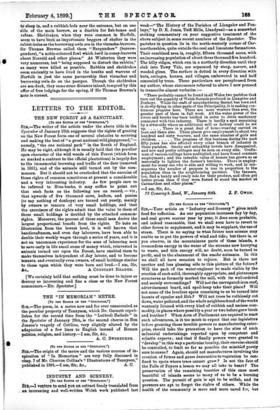INDUSTRY AND SCENERY.
[To THE EDITOR OP THE " SPECTATOR."] venture to send you an extract freely translated from an interesting and well-written Welsh work published last
week—" The History of the Parishes of Llangeler and Pen- boyr," by D. E. Jones, Teifi Mills, Llandyssil—as a somewhat striking commentary on your suggestive treatment of the above subject in some recent numbers of the Spectator. The parishes in question lie in the north-westerly corner of Car- marthenshire, quite outside the coal and limestone formations. Their combined area is, roughly, fifteen thousand acres, with an increasing population of about three thousand five hundred. The hilly ridges, which run in a northerly direction until they sink into Towy Vale, are separated by steep, narrow, and wooded glens. The surface is dotted in every direction with huts, cottages, houses, and villages, embowered in and half concealed by trees. These particulars are paraphrased from my author, whose statements referred to above I now proceed to transcribe almost verbatim :-
"There probably cannot be found in all Wales two parishes that turn out the quantity of Welsh flannels produced in Llangeler and Penboyr. While the craft of manufacturing flannel has been and is slowly dying in other parts of the Principality, it is making con- tinuous progress here. There are more weavers than ever, the greater part of them in full work. All the water power of the rivers and brooks has been bridled in order to drive machinery connected with this industry. There is hardly a spot remaining by a river-side where an additional mill or factory could be set
up There is a great deal of home-weaving carried on here and there also. These places give employment to about two hundred and sixty weavers, and the same number of girls and
children. The progress of this business during the past fifty years has also affected every other branch of industry in these parishes. Smoky and unhealthy hovels have disappeared, and new and pretty cottages may be seen on every side. Crafts- men of various callings have multiplied, and have found constant employment ; and the rateable value of houses has grown so as materially to lighten the farmer's burdens. There is employ- ment for every one who is able and willing to work, and in con- sequence the number of paupers is less in proportion to the population than in the neighbouring parishes. The farmers, too, find a handy and ready sale for their produce, and often get better prices than if they were forced to stand the market at Carmarthen and other places."
—I am, Sir, &c.,
72 Comerag h Road, W., January 50th. J. P. OWEN.


































 Previous page
Previous page